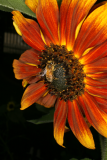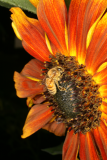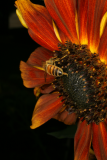Additional notes (click to expand)
Nomenclature
Marigold of Peru, Sunflower, Floure of the Sun
Other use
Helianthus annuus Greene Asteraceae. Sunflower, Marigold of Peru, Floure of the Sun. Distribution: Peru and Mexico. It was much recommended by Gerard (1633) who advises that the buds, covered in flour, boiled, and eaten with 'butter, vinegar and pepper, far surpass artichokes in procuring bodily lust’. Sadly, today only the seeds of sunflower are consumed, as the source of sunflower seed oil used in cooking. It contains mono and polyunsaturated fats, linoleic acid and oleic acid, and is low in saturated fats. As such it was thought to lower cholesterol and so the risk of heart disease, but it may increase the risk of breast and prostatic cancer. However a recent report BMJ2013;346:e8707 concludes that '... clinical benefits ... [of] omega 6 linoleic acid, have not been established. In this cohort, substituting dietary linoleic acid in place of saturated fats increased the rates of death from all causes, coronary heart disease, and cardiovascular disease. An updated meta-analysis of linoleic acid intervention trials showed no evidence of cardiovascular benefit. ...'. It is a rich source of vitamin E. Not in Fuchs (1552), but elegantly illustrated in Lobel (1576) as Solis flos and Chrysanthemum peruvianum. Hybridising and selective breeding can reduce the level of saturated fats even further, as well as producing scarlet flowers like this cultivar. Darwin’s ‘natural selection’ has been replaced by ‘artificial selection’ as the commonest cause of new varieties of plant.
Oakeley, Dr. Henry F. (2013). Wellcome Library notes.
link
Helianthus annuus L. 'Chianti'
Family: ASTERACEAEGenus: Helianthus
Species: annuus L.
Cultivar: 'Chianti'
Common names: Sunflower 'Chianti'
Distribution summary: N.America, Mexico
Habit: Annual
Hardiness: H2 - Tender; cool or frost-free greenhouse
Garden status: Not currently grown
Reason for growing: Medicinal, other use
.JPG)






